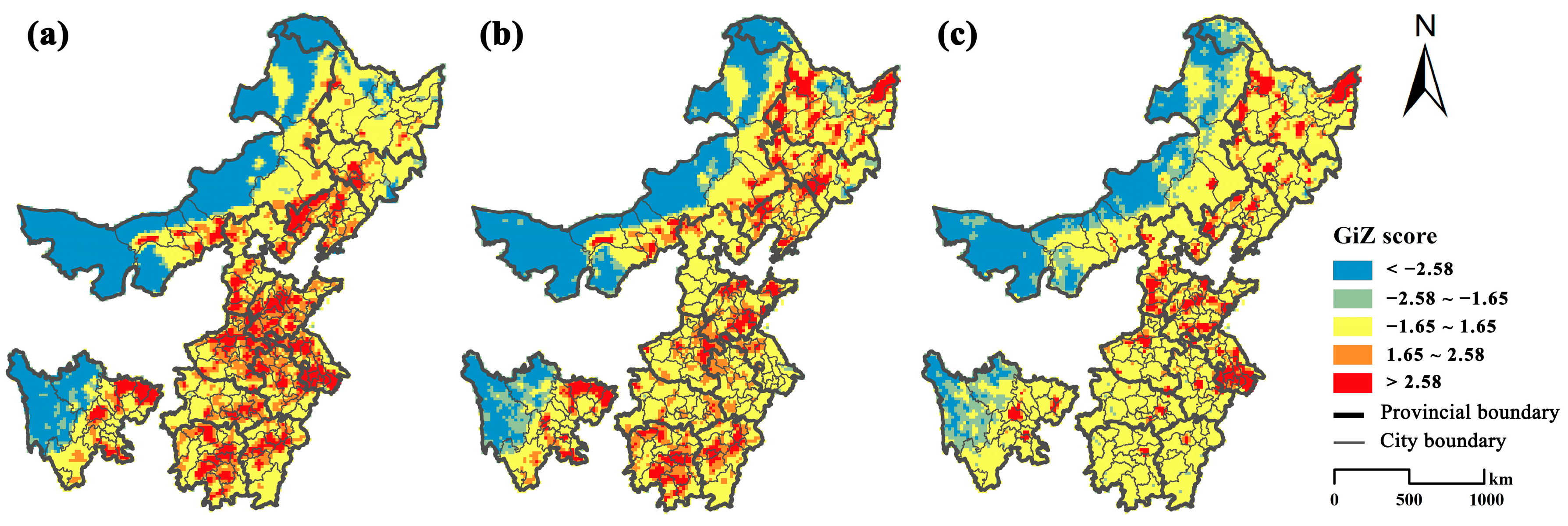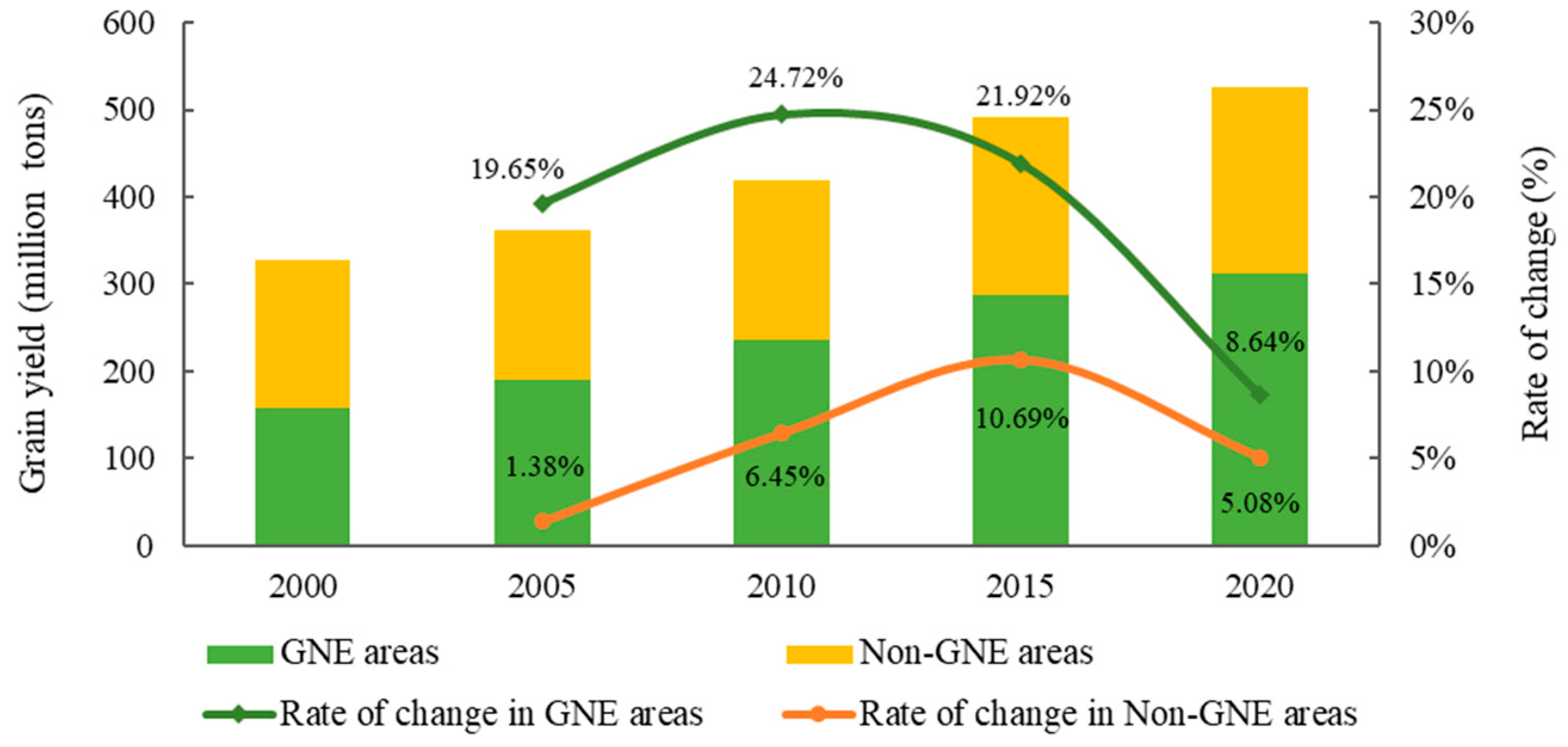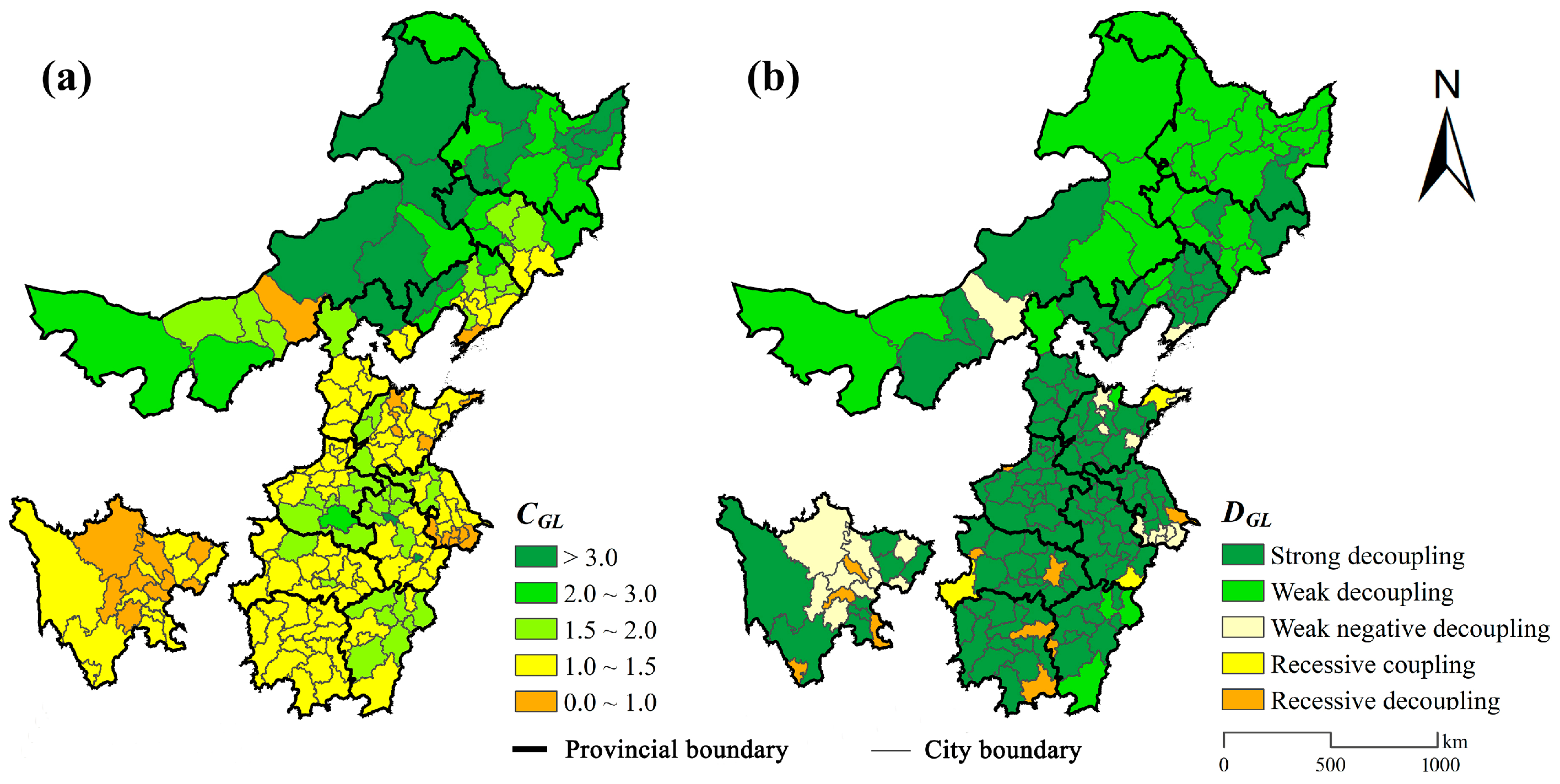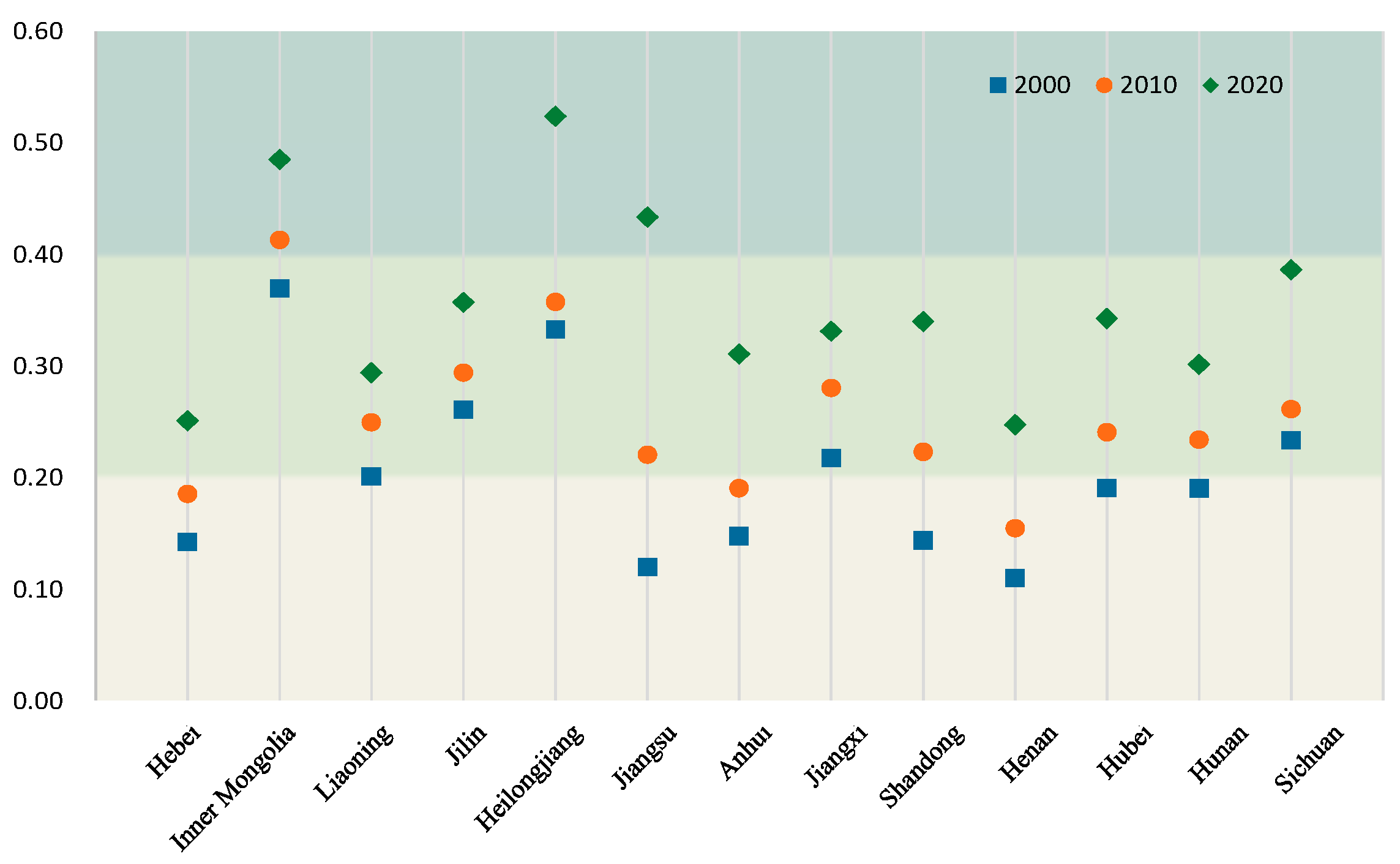Farmland Dynamics and Its Grain Production Efficiency and Ecological Security in China’s Major Grain-Producing Regions between 2000 and 2020
Abstract
:1. Introduction
2. Materials and Methods
2.1. Study Area
2.2. Data
2.3. Methods
2.3.1. Farmland Change Analysis by Land Use Conversion Matrix
2.3.2. Spatial Cold/Hot Spot Analysis of Farmland Loss and Gain
2.3.3. Grain Production Efficiency and Decoupling between Grain Production and Farmland
2.3.4. Ecological Security of Farmland Use
3. Results
3.1. Spatiotemporal Patterns of Farmland Change
3.1.1. Temporal Changes of Farmland during 2000–2020
3.1.2. Spatial Patterns of Farmland Loss and Gain during 2000–2020
3.2. Grain Production Efficiency and Decoupling with Farmland Changes
3.2.1. Growth of Grain Production during 2000–2020 in the GNE and Non-GNE Areas
3.2.2. Spatiotemporal Patterns of Grain Production Efficiency and Decoupling between Grain Production and Farmland
3.3. Land Ecological Security and Its Spatial Pattern
4. Discussion
4.1. Policy Implications for Farmland Conservation in the MGPRs
4.2. Research Implications for Landscape Sustainability of Densely Populated, Rapidly Developing Human–Environment Systems
5. Conclusions
Author Contributions
Funding
Data Availability Statement
Conflicts of Interest
References
- Sustainable Development Goals: 17 Goals to Transform our World. Available online: https://www.un.org/en/exhibits/page/sdgs-17-goals-transform-world (accessed on 8 January 2022).
- Prosekov, A.Y.; Ivanova, S.A. Food security: The challenge of the present. Geoforum 2018, 91, 73–77. [Google Scholar] [CrossRef]
- Wang, Z.; Li, J.; Lai, C.; Wang, R.Y.; Chen, X.; Lian, Y. Drying tendency dominating the global grain production area. Glob. Food Secur. 2018, 16, 138–149. [Google Scholar] [CrossRef]
- Brown, L. Who Will Feed China? Wake-Up Call for a Small Planet; WW Norton & Company: New York, NY, USA, 1995. [Google Scholar]
- Ghose, B. Food security and food self-sufficiency in China: From past to 2050. Food Energy Secur. 2015, 3, 86–95. [Google Scholar] [CrossRef]
- He, C.; Liu, Z.; Xu, M.; Ma, Q.; Dou, Y. Urban expansion brought stress to food security in China: Evidence from decreased cropland net primary productivity. Sci. Total Environ. 2017, 576, 660–670. [Google Scholar] [CrossRef]
- Huang, J.; Wei, W.; Cui, Q.; Xie, W. The prospects for China’s food security and imports: Will China starve the world via imports? J. Integr. Agric. 2017, 16, 2933–2944. [Google Scholar] [CrossRef]
- Yu, Y.; Feng, K.; Hubacek, K.; Sun, L. Global Implications of China’s Future Food Consumption. J. Ind. Ecol. 2016, 20, 593–602. [Google Scholar] [CrossRef] [Green Version]
- Ali, T.; Huang, J.; Wang, J.; Xie, W. Global footprints of water and land resources through China’s food trade. Glob. Food Secur. 2017, 12, 139–145. [Google Scholar] [CrossRef]
- Anderson, K.; Peng, C.Y. Feeding and fueling China in the 21st century. World Dev. 1998, 26, 1413–1429. [Google Scholar] [CrossRef]
- Chen, L.; Hu, Y.; Han, X.; Guo, X. The quantitative comparative analysis of food production and contribution of major grain production areas in national food security. Chin. Land Sci. 2017, 31, 32–42. (In Chinese) [Google Scholar]
- Li, Y.; Xiong, W. A spatial panel data analysis of China’s urban land expansion, 2004–2014. Pap. Reg. Sci. 2019, 98, 393–407. [Google Scholar] [CrossRef] [Green Version]
- Zhao, X.; Zhang, M.; Li, Y.; Huang, X.; Wang, B.; Zhang, L. Urban residential land expansion and agglomeration in China: A spatial analysis approach. Environ. Dev. Sustain. 2020, 22, 5317–5335. [Google Scholar] [CrossRef]
- Liu, J.; Liu, Y.; Yan, M. Spatial and temporal change in urban-rural land use transformation at village scale—A case study of Xuanhua district, North China. J. Rural Stud. 2016, 47, 425–434. [Google Scholar] [CrossRef]
- Wang, S.; Zuo, Q.; Zhou, K.; Wang, J.; Wang, W. Predictions of Land Use/Land Cover Change and Landscape Pattern Analysis in the Lower Reaches of the Tarim River, China. Land 2023, 12, 1093. [Google Scholar] [CrossRef]
- Chen, W.; Ye, X.; Li, J.; Fan, X.; Liu, Q.; Dong, W. Analyzing requisition–compensation balance of farmland policy in China through telecoupling: A case study in the middle reaches of Yangtze River Urban Agglomerations. Land Use Policy 2019, 83, 134–146. [Google Scholar] [CrossRef]
- Qie, L.; Pu, L.; Tang, P.; Liu, R.; Huang, S.; Xu, F.; Zhong, T. Gains and losses of farmland associated with farmland protection policy and urbanization in China: An integrated perspective based on goal orientation. Land Use Policy 2023, 129, 106643. [Google Scholar] [CrossRef]
- Long, H.; Ge, D.; Zhang, Y.; Tu, S.; Qu, Y.; Ma, L. Changing man-land interrelations in China’s farming area under urbanization and its implications for food security. J. Environ. Manag. 2018, 209, 440–451. [Google Scholar] [CrossRef]
- Wu, X.; Yuan, Z. Understanding the socio-cultural resilience of rural areas through the intergenerational relationship in transitional China: Case studies from Guangdong. J. Rural Stud. 2023, 97, 303–313. [Google Scholar] [CrossRef]
- Lv, L.; Zhou, S.; Zhou, B. Land use transformation and its eco-environmental response in process of the regional development: A case study of Jiangsu province. Sci. Geogr. Sin. 2013, 33, 1442–1449. (In Chinese) [Google Scholar]
- Wang, J.; Lin, Y.; Glendinning, A.; Xu, Y. Land-use changes and land policies evolution in China’s urbanization processes. Land Use Policy 2018, 75, 375–387. [Google Scholar] [CrossRef]
- Wang, J.; Chen, Y.; Shao, X.; Zhang, Y.; Cao, Y. Land-use changes and policy dimension driving forces in China: Present, trend and future. Land Use Policy 2012, 29, 737–749. [Google Scholar] [CrossRef]
- Kuang, W.H.; Liu, J.Y.; Zhang, Z.X.; Dengsheng, L.U.; Xiang, B. Spatiotemporal dynamics of impervious surface areas across China during the early 21st century. Chin. Sci. Bull. 2013, 58, 1691–1701. [Google Scholar] [CrossRef] [Green Version]
- Long, H.; Qu, Y. Land use transitions and land management: A mutual feedback perspective. Land Use Policy 2018, 74, 111–120. [Google Scholar] [CrossRef]
- Deng, X.; Huang, J.; Rozelle, S.; Uchida, E. Cultivated land conversion and potential agricultural productivity in China. Land Use Policy 2006, 23, 372–384. [Google Scholar] [CrossRef]
- Liu, J.; Kuang, W.; Zhang, Z.; Xu, X.; Qin, Y.; Ning, J.; Zhou, W.; Zhang, S.; Li, R.; Yan, C.; et al. Spatiotemporal characteristics, patterns and causes of land use changes in China since the late 1980s. J. Geogr. Sci. 2014, 24, 195–210. [Google Scholar] [CrossRef]
- Ning, J.; Liu, J.; Kuang, W.; Xu, X.; Zhang, S.; Yan, C.; Li, R.; Wu, S.; Hu, Y.; Du, G.; et al. Spatiotemporal patterns and characteristics of land-use change in China during 2010–2015. J. Geogr. Sci. 2018, 28, 547–562. [Google Scholar] [CrossRef] [Green Version]
- Liu, L.; Xu, X.; Chen, X. Assessing the impact of urban expansion on potential crop yield in China during 1990–2010. Food Secur. 2015, 7, 33–43. [Google Scholar] [CrossRef] [Green Version]
- Kong, X. China must protect high-quality arable land. Nature 2014, 506, 7. [Google Scholar] [CrossRef] [Green Version]
- Long, H.; Li, Y.; Liu, Y.; Woods, M.; Jian, Z. Accelerated restructuring in rural China fueled by ‘increasing vs. decreasing balance’ land-use policy for dealing with hollowed villages. Land Use Policy 2012, 29, 11–22. [Google Scholar]
- Wu, Y.; Shan, L.; Guo, Z.; Peng, Y. Cultivated land protection policies in China facing 2030: Dynamic balance system versus basic farmland zoning. Habitat Int. 2017, 69, 126–138. [Google Scholar] [CrossRef]
- Zhong, T.; Mitchell, B.; Scott, S.; Huang, X.; Li, Y.; Lu, X. Growing centralization in China’s farmland protection policy in response to policy failure and related upward-extending unwillingness to protect farmland since 1978. Env. Plan. C-Polit. Space 2017, 35, 1075–1097. [Google Scholar] [CrossRef]
- Zhang, R.; Zheng, H.; Liu, Y. Evaluation on cultivated land ecological security based on the PSR model and matter element analysis. Acta Ecol. Sin. 2013, 33, 5090–5100. [Google Scholar] [CrossRef]
- Li, L.; Huang, X.; Wu, D.; Yang, H. Construction of ecological security pattern adapting to future land use change in Pearl River Delta, China. Appl. Geogr. 2023, 154, 102946. [Google Scholar] [CrossRef]
- Ignatieva, M.; Stewart, G.H.; Meurk, C. Planning and design of ecological networks in urban areas. Landsc. Ecol. Eng. 2011, 7, 17–25. [Google Scholar] [CrossRef]
- Peng, J.; Pan, Y.; Liu, Y.; Zhao, H.; Wang, Y. Linking ecological degradation risk to identify ecological security patterns in a rapidly urbanizing landscape. Habitat Int. 2018, 71, 110–124. [Google Scholar] [CrossRef]
- Li, Y.; Liu, W.; Feng, Q.; Zhu, M.; Yang, L.; Zhang, J.; Yin, X. The role of land use change in affecting ecosystem services and the ecological security pattern of the Hexi Regions, Northwest China. Sci. Total Environ. 2023, 855, 158940. [Google Scholar] [CrossRef]
- Nie, W.; Xu, B.; Yang, F.; Shi, Y.; Liu, B.; Wu, R.; Lin, W.; Pei, H.; Bao, Z. Simulating future land use by coupling ecological security patterns and multiple scenarios. Sci. Total Environ. 2023, 859, 160262. [Google Scholar] [CrossRef]
- Wei, J.; Tian, M.; Wang, X. Spatiotemporal Variation in Land Use and Ecosystem Services during the Urbanization of Xining City. Land 2023, 12, 1118. [Google Scholar] [CrossRef]
- Jiang, Y.; Du, G.; Teng, H.; Wang, J.; Li, H. Multi-Scenario Land Use Change Simulation and Spatial Response of Ecosystem Service Value in Black Soil Region of Northeast China. Land 2023, 12, 962. [Google Scholar] [CrossRef]
- Wang, X.; Wang, D.; Wu, S.; Yan, Z.; Han, J. Cultivated land multifunctionality in undeveloped peri-urban agriculture areas in China: Implications for sustainable land management. J. Environ. Manag. 2023, 325, 116500. [Google Scholar] [CrossRef]
- Ding, Z.; Yao, S. Theory and valuation of cross-regional ecological compensation for cultivated land: A case study of Shanxi province, China. Ecol. Indic. 2022, 136, 108609. [Google Scholar] [CrossRef]
- Xue, X.; Ma, L. Analysis on the coupling and coordination of land ecological and food security in main producing areas. Chin. J. Agric. Resour. Reg. Plan. 2022, 43, 1–11. (In Chinese) [Google Scholar]
- Liu, J.; Zhang, Z.; Xu, X.; Kuang, W.; Zhou, W.; Zhang, S.; Li, R.; Yan, C.; Yu, D.; Wu, S. Spatial patterns and driving forces of land use change in China during the early 21st century. J. Geogr. Sci. 2010, 20, 483–494. [Google Scholar] [CrossRef]
- Liu, J.; Liu, M.; Zhuang, D.; Zhang, Z.; Deng, X. Study on spatial pattern of land-use change in China during 1995–2000. Sci. China Ser. D-Earth Sci. 2003, 46, 373–384. [Google Scholar]
- Luo, D.; Zhang, W. Comparison of Markov model-based methods for predicting the ecosystem service value of land use in Wuhan, central China. Ecosyst. Serv. 2014, 7, 57–65. [Google Scholar] [CrossRef]
- Liu, H.; Ma, L.; Li, G. Pattern evolution and its contributory factor of cold spots and hot spots of economic development in Beijing-Tianjin-Hebei region. Geogr. Res. 2017, 36, 97–108. [Google Scholar]
- Lv, L.; Li, Y.; Sun, Y. The spatio-temporal pattern of regional land use change and eco-environmental responses in Jiangsu, China. J. Resour. Ecol. 2017, 8, 268–276. [Google Scholar]
- Anselin, L. Local indicators of spatial association—LISA. Geogr. Anal. 1995, 27, 93–115. [Google Scholar] [CrossRef]
- Getis, A.; Ord, J.K. The Analysis of Spatial Association by Use of Distance Statistics. Geogr. Anal. 1992, 24, 189–206. [Google Scholar] [CrossRef]
- Tapio, P. Towards a theory of decoupling: Degrees of decoupling in the EU and the case of road traffic in Finland between 1970 and 2001. Transp. Policy 2005, 12, 137–151. [Google Scholar] [CrossRef] [Green Version]
- OECD. Indicators to Measure Decoupling of Environmental Pressure from Economic Growth; OECD Publishing: Berlin, Germany, 2002. [Google Scholar]
- Falb, P.; Wolovich, W. Decoupling in the design and synthesis of multivariable control systems. IEEE Trans. Autom. Control 1967, 12, 651–659. [Google Scholar] [CrossRef] [Green Version]
- Andreoni, V.; Galmarini, S. Decoupling economic growth from carbon dioxide emissions: A decomposition analysis of Italian energy consumption. Energy 2012, 44, 682–691. [Google Scholar] [CrossRef]
- Zhong, T.; Huang, X.; Wang, B. On the degrees of decoupling and re-coupling of economic growth and expansion of construction land in China from 2002 to 2007. J. Nat. Resour. 2010, 25, 18–31. (In Chinese) [Google Scholar]
- He, N.; Zhou, Y.; Wang, L.; Li, Q.; Zuo, Q.; Liu, J.; Li, M. Spatiotemporal evaluation and analysis of cultivated land ecological security based on the DPSIR model in Enshi autonomous prefecture, China. Ecol. Indic. 2022, 145, 109619. [Google Scholar] [CrossRef]
- Liu, Y. Scientifically promoting the strategy of reclamation and readjustment of rural land in China. Chin. Land Sci. 2011, 25, 3–8. (In Chinese) [Google Scholar]
- Long, H. Land consolidation and rural spatial restructuring. Acta Geogr. Sin. 2013, 68, 1019–1028. (In Chinese) [Google Scholar]
- Zhou, J.; Cao, X. What is the policy improvement of China’s land consolidation? Evidence from completed land consolidation projects in Shaanxi Province. Land Use Policy 2020, 99, 104847. [Google Scholar] [CrossRef]
- Fang, X.; Zhou, B.; Tu, X.; Ma, Q.; Wu, J. “What Kind of a Science is Sustainability Science?” An Evidence-Based Reexamination. Sustainability 2018, 10, 1478. [Google Scholar] [CrossRef] [Green Version]
- Liu, J.; Dietz, T.; Carpenter, S.R.; Folke, C.; Alberti, M.; Redman, C.L.; Schneider, S.H.; Ostrom, E.; Pell, A.N.; Lubchenco, J.; et al. Coupled human and natural systems. AMBIO 2007, 36, 639–649. [Google Scholar] [CrossRef] [PubMed]
- Bai, X.; Chen, J.; Shi, P. Landscape urbanization and economic growth in China: Positive feedbacks and sustainability dilemmas. Environ. Sci. Technol. 2012, 46, 132–139. [Google Scholar] [CrossRef] [PubMed]
- Fuglie, K.O. Is agricultural productivity slowing? Glob. Food Secur. 2018, 17, 73–83. [Google Scholar] [CrossRef]
- Ge, D.; Long, H.; Zhang, Y.; Ma, L.; Li, T. Farmland transition and its influences on grain production in China. Land Use Policy 2018, 70, 94–105. [Google Scholar] [CrossRef]
- Yi, F.; Sun, D.; Zhou, Y. Grain subsidy, liquidity constraints and food security—Impact of the grain subsidy program on the grain-sown areas in China. Food Pol. 2015, 50, 114–124. [Google Scholar] [CrossRef] [Green Version]
- Zhan, S. Riding on self-sufficiency: Grain policy and the rise of agrarian capital in China. J. Rural Stud. 2017, 54, 151–161. [Google Scholar] [CrossRef]
- Zhou, D.; Xu, J.; Lin, Z. Conflict or coordination? Assessing land use multi-functionalization using production-living-ecology analysis. Sci. Total Environ. 2017, 577, 136–147. [Google Scholar] [CrossRef]
- Fischer, J.; Riechers, M. A leverage points perspective on sustainability. People Nat. 2019, 1, 115–120. [Google Scholar] [CrossRef] [Green Version]
- Loorbach, D.; Frantzeskaki, N.; Avelino, F. Sustainability Transitions Research: Transforming Science and Practice for Societal Change. Annu. Rev. Environ. Resour. 2017, 42, 599–626. [Google Scholar] [CrossRef]
- Li, Y.; Cheng, H.; Beeton, R.J.S.; Sigler, T.; Halog, A. Sustainability from a Chinese cultural perspective: The implications of harmonious development in environmental management. Environ. Dev. Sustain. 2016, 18, 679–696. [Google Scholar] [CrossRef]
- Godfray, H.C.J.; Beddington, J.R.; Crute, I.R.; Haddad, L.; Lawrence, D.; Muir, J.F.; Pretty, J.; Robinson, S.; Thomas, S.M.; Toulmin, C. Food security: The challenge of feeding 9 billion people. Science 2010, 327, 812–818. [Google Scholar] [CrossRef] [Green Version]
- Lambin, E.F.; Meyfroidt, P. Global land use change, economic globalization, and the looming land scarcity. Proc. Natl. Acad. Sci. USA 2011, 108, 3465–3472. [Google Scholar] [CrossRef]
- Zhong, T.; Huang, X.; Zhang, X.; Scott, S.; Wang, K. The effects of basic arable land protection planning in Fuyang County, Zhejiang Province, China. Appl. Geogr. 2012, 35, 422–438. [Google Scholar] [CrossRef]
- Liu, J.; Xu, X.; Zhuang, D.; Gao, Z. Impacts of LUCC processes on potential land productivity in China in the 1990s. Sci. China Ser. D-Earth Sci. 2005, 48, 1259–1269. [Google Scholar] [CrossRef]
- Long, H.; Heilig, G.K.; Li, X.; Zhang, M. Socio-economic development and land-use change: Analysis of rural housing land transition in the Transect of the Yangtse River, China. Land Use Policy 2007, 24, 141–153. [Google Scholar] [CrossRef]
- Liu, Y.; Liu, Y.; Chen, Y.; Long, H. The process and driving forces of rural hollowing in China under rapid urbanization. J. Geogr. Sci. 2010, 20, 876–888. [Google Scholar] [CrossRef]
- Rada, N.; Wang, C.; Qin, L. Subsidy or market reform? Rethinking China’s farm consolidation strategy. Food Pol. 2015, 57, 93–103. [Google Scholar] [CrossRef]
- Ntihinyurwa, P.D.; de Vries, W.T. Farmland Fragmentation, Farmland Consolidation and Food Security: Relationships, Research Lapses and Future Perspectives. Land 2021, 10, 129. [Google Scholar] [CrossRef]
- Lv, L.; Gao, Z.; Liao, K.; Zhu, Q.; Zhu, J. Impact of conservation tillage on the distribution of soil nutrients with depth. Soil Tillage Res. 2023, 225, 105527. [Google Scholar] [CrossRef]
- Foley, J.A.; DeFries, R.; Asner, G.P.; Barford, C.; Bonan, G.; Carpenter, S.R.; Chapin, F.S.; Coe, M.T.; Daily, G.C.; Gibbs, H.K.; et al. Global consequences of land use. Science 2005, 309, 570–574. [Google Scholar] [CrossRef] [Green Version]
- Mustard, J.F.; DeFries, R.S.; Fisher, T.; Moran, E. Land-use and land-cover change pathways and impacts. In Land Change Science: Observing, Monitoring and Understanding Trajectories of Change on the Earth’s Surface; Gutman, G., Janetos, A.C., Justice, C.O., Moran, E.F., Mustard, J.F., Rindfuss, R.R., Skole, D., Turner, B.L., II, Cochrane, M.A., Eds.; Springer Science & Business Media: Dordrecht, The Netherlands, 2004. [Google Scholar]
- Pandey, B.; Seto, K.C. Urbanization and agricultural land loss in India: Comparing satellite estimates with census data. J. Environ. Manag. 2015, 148, 53–66. [Google Scholar] [CrossRef]
- Nguyen, T.H.T.; Tran, V.T.; Bui, Q.T.; Man, Q.H.; Walter, T.d.V. Socio-economic effects of agricultural land conversion for urban development: Case study of Hanoi, Vietnam. Land Use Policy 2016, 54, 583–592. [Google Scholar] [CrossRef]
- Bren d’Amour, C.; Reitsma, F.; Baiocchi, G.; Barthel, S.; Güneralp, B.; Erb, K.-H.; Haberl, H.; Creutzig, F.; Seto, K.C. Future urban land expansion and implications for global croplands. Proc. Natl. Acad. Sci. USA 2017, 114, 8939–8944. [Google Scholar] [CrossRef]
- Tan, M.; Li, X.; Xie, H.; Lu, C. Urban land expansion and arable land loss in China—A case study of Beijing–Tianjin–Hebei region. Land Use Policy 2005, 22, 187–196. [Google Scholar] [CrossRef]
- Deng, X.; Huang, J.; Rozelle, S.; Zhang, J.; Li, Z. Impact of urbanization on cultivated land changes in China. Land Use Policy 2015, 45, 1–7. [Google Scholar] [CrossRef]
- Song, W.; Pijanowski, B.C.; Tayyebi, A. Urban expansion and its consumption of high-quality farmland in Beijing, China. Ecol. Indic. 2015, 54, 60–70. [Google Scholar] [CrossRef]
- Huang, Z.; Du, X.; Castillo, C.S.Z. How does urbanization affect farmland protection? Evidence from China. Resour. Conserv. Recycl. 2019, 145, 139–147. [Google Scholar] [CrossRef] [Green Version]







| Category | Indicator | Measuring Unit | Attribute 1 | Weight |
|---|---|---|---|---|
| Driver | Population density | person per km2 | − | 0.043 |
| Economy density | 10 thousand yuan per km2 | + | 0.223 | |
| Pressure | Urbanization rate | % | + | 0.046 |
| Agricultural fertilizer usage | tons per hm2 | − | 0.035 | |
| State | Farmland per person | hm2 per person | + | 0.199 |
| Water resource per person | m3 per person | + | 0.130 | |
| Impact | Grain yield per unit | tons per hm2 | + | 0.036 |
| Proportion of tertiary industry | % | + | 0.052 | |
| Response | Recovery area for soil erosion | hm2 | + | 0.081 |
| Investment in pollution control | 10 thousand yuan | + | 0.153 |
| 2000 | 2020 | |||||
|---|---|---|---|---|---|---|
| Farmland | Forest Land | Grassland | Water Body | Construction Land | Unused Land | |
| Farmland | 8683.58 | 1149.67 | 496.29 | 239.03 | 1062.89 | 98.39 |
| Forest land | 1163.48 | 8872.33 | 792.87 | 69.23 | 93.35 | 170.68 |
| Grassland | 599.00 | 881.46 | 6370.00 | 62.50 | 90.53 | 398.61 |
| Water body | 207.35 | 57.67 | 45.58 | 559.40 | 35.43 | 84.73 |
| Construction land | 632.65 | 36.31 | 35.72 | 51.38 | 473.59 | 10.32 |
| Unused land | 183.58 | 63.64 | 341.93 | 49.32 | 21.13 | 3127.88 |
| Type of Change | Studied Period | Region | |||||
|---|---|---|---|---|---|---|---|
| Grain-Net-Exporting (GNE) Areas | Non-GNE Areas | Major Grain-Producing Regions (MGPRs) | |||||
| Amount | Rate of Change | Amount | Rate of Change | Amount | Rate of Change | ||
| Net change in grain production (ΔG, 104 t) | 2000–2005 | 3111 | 19.6% | 234 | 1.4% | 3345 | 10.2% |
| 2006–2010 | 4683 | 24.7% | 1110 | 6.5% | 5793 | 16.0% | |
| 2011–2015 | 5179 | 21.9% | 1957 | 10.7% | 7136 | 17.0% | |
| 2016–2020 | 2489 | 8.6% | 1029 | 5.1% | 3518 | 7.2% | |
| 2000–2020 | 15,463 | 97.6% | 4330 | 25.5% | 19,793 | 60.3% | |
| Net change in farmland (ΔL, km2) | 2000–2005 | −688 | −0.1% | −4077 | −0.8% | −4765 | −0.4% |
| 2006–2010 | −1229 | −0.2% | −2993 | −0.6% | −4222 | −0.4% | |
| 2011–2015 | −421 | −0.1% | −5166 | −1.0% | −5587 | −0.5% | |
| 2016–2020 | 5260 | 0.8% | −16060 | −3.1% | −10800 | −0.9% | |
| 2000–2020 | 2922 | 0.5% | −28,296 | −5.3% | −25,374 | −2.2% | |
| CGL (improvement of grain production efficiency) | 2000–2005 | 1.20 | 1.02 | 1.11 | |||
| 2006–2010 | 1.25 | 1.07 | 1.16 | ||||
| 2011–2015 | 1.22 | 1.12 | 1.18 | ||||
| 2015–2020 | 1.08 | 1.07 | 1.08 | ||||
| 2000–2020 | 1.97 | 1.33 | 1.64 | ||||
| DGL (decoupling grain production from farmland quantity) | 2000–2005 | −0.005 | −0.558 | −0.040 | |||
| 2006–2010 | −0.008 | −0.088 | −0.023 | ||||
| 2011–2015 | −0.003 | −0.093 | −0.028 | ||||
| 2015–2020 | 0.095 | −0.611 | −0.130 | ||||
| 2000–2020 | 0.005 | −0.209 | −0.036 | ||||
Disclaimer/Publisher’s Note: The statements, opinions and data contained in all publications are solely those of the individual author(s) and contributor(s) and not of MDPI and/or the editor(s). MDPI and/or the editor(s) disclaim responsibility for any injury to people or property resulting from any ideas, methods, instructions or products referred to in the content. |
© 2023 by the authors. Licensee MDPI, Basel, Switzerland. This article is an open access article distributed under the terms and conditions of the Creative Commons Attribution (CC BY) license (https://creativecommons.org/licenses/by/4.0/).
Share and Cite
Li, Y.; Han, X.; Zhou, B.; Lv, L.; Fan, Y. Farmland Dynamics and Its Grain Production Efficiency and Ecological Security in China’s Major Grain-Producing Regions between 2000 and 2020. Land 2023, 12, 1404. https://doi.org/10.3390/land12071404
Li Y, Han X, Zhou B, Lv L, Fan Y. Farmland Dynamics and Its Grain Production Efficiency and Ecological Security in China’s Major Grain-Producing Regions between 2000 and 2020. Land. 2023; 12(7):1404. https://doi.org/10.3390/land12071404
Chicago/Turabian StyleLi, Ying, Xu Han, Bingbing Zhou, Ligang Lv, and Yeting Fan. 2023. "Farmland Dynamics and Its Grain Production Efficiency and Ecological Security in China’s Major Grain-Producing Regions between 2000 and 2020" Land 12, no. 7: 1404. https://doi.org/10.3390/land12071404
APA StyleLi, Y., Han, X., Zhou, B., Lv, L., & Fan, Y. (2023). Farmland Dynamics and Its Grain Production Efficiency and Ecological Security in China’s Major Grain-Producing Regions between 2000 and 2020. Land, 12(7), 1404. https://doi.org/10.3390/land12071404








